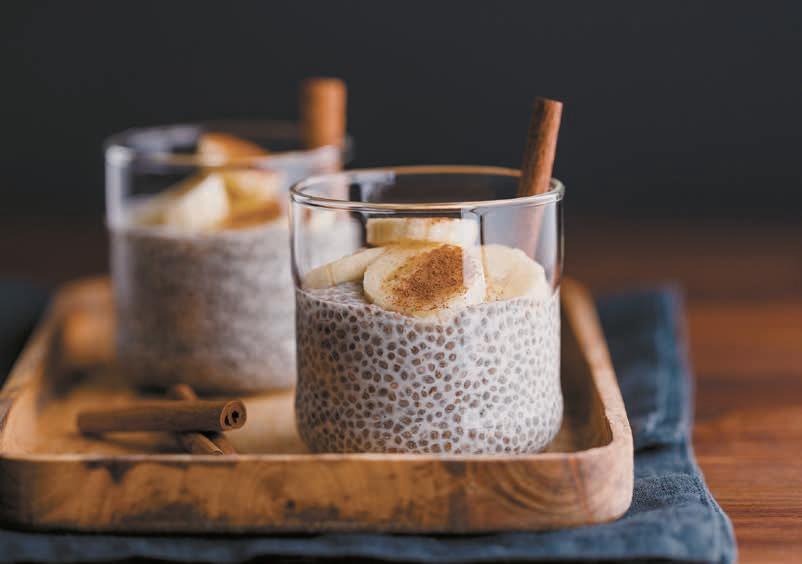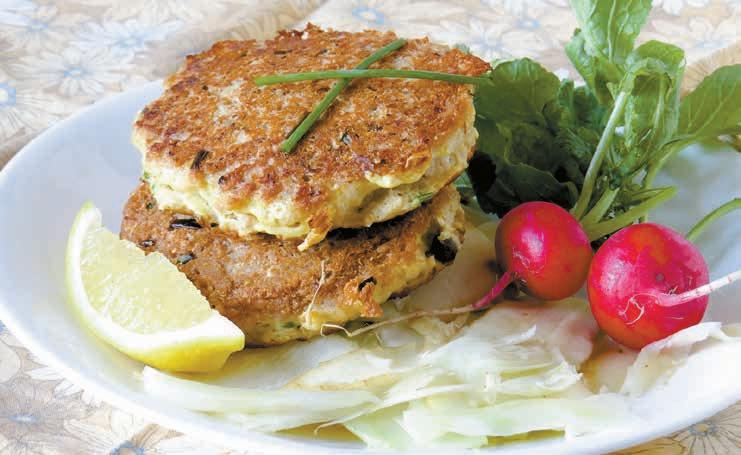
9 minute read
A BETTER BREAKFAST
from Natural Awakenings Magazine, Broward County, Florida. October 2020
by Natural Awakenings, Broward and Palm Beach Counties, Florida
edalin/AdobeStock.com
Healthy Tips and Recipes to Start the Day
Advertisement
by April Thompson
Breakfast sets the stage for the day ahead, and it can either drain or energize us, depending on the what, when and how much aspects of the meal. While health experts agree that many traditional breakfast foods can do more harm than good, delicious, healthy alternatives are within easy reach of the breakfast table. Morning favorites like pastries, sugary cereals and pancakes, high in refined sugars and carbs, cause insulin production to spike and blood sugar levels to crash, according to David Perlmutter, an acclaimed neurologist based in Naples, Florida, and author of Grain Brain: The Surprising Truth about Wheat, Carbs, and Sugar - Your Brain’s Silent Killers. “People need to train their bodies to tap into the energy reserves within, harvesting fat for energy rather than being reliant on the next meal. A breakfast high in protein and fat will do that,” he says. While often waiting until noon for his first meal of the day, Perlmutter frequently opts for eggs and salad drenched in an extra-virgin olive oil dressing to break the fast. Perlmutter suggests waiting 12 hours or longer between dinner and the next day’s breakfast. “Time-restricted eating”, or intermittent fasting, can have surprising health benefits, helping crank up production of the brain-derived neurotrophic factor, a powerful initiator for growth of new brain cells, and kick-start autophagy, the body’s method of cleaning out damaged cells, according to the neurologist. A plant-based chef based in Bruges, Belgium, Julie Van den Kerchove switched from a raw, vegan diet to a mainly keto diet, low in carbohydrates, to regain energy after “hitting a wall, experiencing hormonal imbalances and nutritional deficiencies. Before, I would have green smoothies with lots of fruit and leafy greens, but would be ‘hangry’ a few hours later. Now my breakfast consists more of healthy fats and proteins, which helps me stay satisfied and energized until lunchtime. I experience more mental clarity and calmness because my blood sugar is not going up and down,” says Van den Kerchove, a blogger and author of vegan, raw-food and keto cookbooks. A typical breakfast for her now is a chia seed pudding with a nut or coconut milk, berries, nuts and seeds with a protein powder and stevia, which is easy to prepare in advance, or a warm porridge with hemp seeds, nut butter, chia seeds and almond, hemp or coconut milk, which is high in fiber and healthy fats. “If I feel like [having] something savory, I’ll have seed crackers topped with avocado and eggs or a Mediterranean omelet,” she adds.
Teresa Fung, a professor of nutrition at Simmons University and adjunct professor at Harvard University, both in Boston, cautions about completely cutting carbs from breakfast, however. “Fruits and vegetables are important healthy sources of carbs, essential to get enough fiber to maintain healthy gut microbiome and feed the good bacteria in your GI tract,” says Fung, who is an associate editor for The Journal of Nutrition. “Optimal morning fuel will include a good dose of protein, vitamins and minerals, fiber, antioxidants and some heart-healthy fats. It will also include a healthy source of carbs that your body can use as energy, leaving proteins to be used for protein synthesis,” says Fung, suggesting a simple, but hearty breakfast of high-fiber oatmeal or yogurt with nuts and fruit.
Like Perlmutter, Fung stresses the importance of eating during daylight hours when certain enzymes are activated. “Our bodies react to daylight even when our eyes are still closed. Eating should match up with our biological clocks, as we are daytime animals, using most of our energy in the day,” she says.
Fung notes Americans that tend to make breakfast the smallest meal of the day and dinner the largest need to better balance meal sizes rather than load up on calories late in the day.
These experts agree on the need to tune into the body’s signals for hunger and satiety, not just eating breakfast on an autopilot schedule. “If I’ve eaten a huge holiday dinner the night before, I may skip my morning meal. I’m a huge proponent in being flexible and listening to your body,” says Van den Kerchove.
Connect with Washington, D.C., freelance writer April Thompson at AprilWrites.com.
Caramel Apple Cinnamon Crisp Overnight Oats These oats are a great dessert/breakfast mix that’s delicious, but good for you, too. It’s made clean by cooking the apples using coconut sugar instead of refined white sugar and adding cinnamon and nutmeg for spice. Prep the oats by mixing all the ingredients, then make a date caramel sauce that’s healthier than any caramel sauce you can purchase from the grocery store and so luscious that you’ll fall in love with it.
For the Cinnamon Apples:
2 large Honeycrisp or Pink Lady apples, cored, peeled and diced 2 Tbsp coconut sugar ⅛ tsp cinnamon ⅛ tsp nutmeg
For the Oats:
1½ cups rolled oats 1½ cups unsweetened almond milk 2 Tbsp chia seeds 1 tsp vanilla extract
Salmon Cakes with Fennel & Parsnips For the vegetables:
½ cup fennel, shaved thin (use a mandolin slicer for thinnest slices) ¼ cup parsnips, shaved ½ Tbsp coconut oil
For the salmon cakes:
6 oz can boneless, skinless, wild-caught salmon, drained 1 egg 1 Tbsp quinoa flakes 1 Tbsp fresh chives, chopped 1 tsp capers 1 tsp lemon juice ½ Tbsp coconut oil, for frying 4 radishes with greens Heat oil in a skillet and sauté fennel and parsnips until tender, about 7 minutes. Remove to serving plate. ¼ tsp ground cinnamon
For the Date Caramel Sauce:
10–12 pitted dried dates ⅛ tsp sea salt ½ cup hot water, divided
To make the cinnamon apples, combine the apples, coconut sugar, cinnamon and nutmeg in a saucepan, and cook over medium heat for 6 to 8 minutes until the apples are softened, but not mushy. For the oats, combine the oats, milk, chia seeds, vanilla and cinnamon in a mixing bowl.
To make the date caramel sauce, process the dates and sea salt in a food processor until they are finely chopped. Add the water, 1 tablespoon at a time, to the dates until the mixture becomes smooth and resembles caramel. You may need to scrape down the sides of the food processor.
Spoon half of the oat mixture into the bottom of an 8-ounce jar with a lid or a quinoa flakes, chives, capers and lemon juice. Stir to mix until most of the large chunks of salmon are broken down. Heat oil in a frying pan over medium heat, form salmon mixture into 2 patties and

sealable container, then top with the date sauce and apples. Repeat in a second jar with the remaining ingredients. Refrigerate the oats overnight or for at least 4 hours. The oats can be enjoyed cold straight from the refrigerator or heated in the microwave for 1 to 2 minutes.
Reprinted from Clean-Eating Breakfasts

and Lunches Made Simple, by Lacey Baier. cook 4 minutes per side. Place salmon cakes over fennel and parsnips and garnish with radishes. Serve warm.
Provided by David Perlmutter, DrPerlmutter.com.
Sweet Potato Toast with Avocado

1 large sweet potato 1 ripe avocado, sliced 1 package of tempeh (or 2 eggs) Extra-virgin coconut or olive oil Black pepper and sea salt Cauliflower Hash Egg Muffins This is a healthier, low-calorie alternative to the classic breakfast of hash browns and eggs, and more nutritious, too, because cauliflower is packed with fiber, minerals and vitamins. Plus, eating muffins for breakfast is always a good idea, especially when the muffins are good for you. Fortunately, there are ways to make hash browns clean, because they’re amazing and need to be in the food rotation. First, use a Smoked paprika and turmeric (optional) 2 large handfuls spinach or kale (optional) 1 to 2 Tbsp MCT oil (optional)
If using organic sweet potatoes, you don’t need to peel them because the skin contains lots of minerals and flavor. Just rinse and dry.
Cut the sweet potato in thin slices of 0.2 to 0.4 of an inch. Put them in your toaster on its highest setting. Repeat three to four times until the sweet potato is completely cooked.
You could also use your oven to make the sweet potato toast. Preheat at 350° F and roast for 5 to 10 minutes. Rub the sweet potato slices with some extra virgin coconut oil or olive oil and sea salt.
In the meantime, heat a spoonful of extra little bit of olive oil instead of deep-frying, and opt for a healthier, low-carb alternative for potatoes, like cauliflower. Then, turn everything into muffins. Because it’s easier to prepare, they are great for a make-ahead breakfast and the flavors will be better. ½ Tbsp olive oil, plus more for greasing the pan ½ cup finely diced yellow onion 3 cups riced cauliflower 2 egg whites ¼ cup grated Parmesan cheese ½ tsp sea salt ¼ tsp ground black pepper ¼ tsp garlic powder 12 eggs 2 green onions, sliced, for garnish Preheat the oven to 425° F and grease a 12-cup muffin pan with olive oil. Heat the olive oil over medium-high heat in a large skillet. Add the onion, and cook until tender, 4 to 6 minutes. Add the cauliflower and cook until it becomes slightly tender, 3 to 4 minutes. Transfer the cauliflower mixture to a large bowl, then add the egg whites, Parmesan, virgin coconut oil in a frying pan. Cut the tempeh in smaller pieces and fry until golden. Flavor with black pepper and sea salt. I also love adding smoked paprika and turmeric. If you wish, you can add two large handfuls of spinach too.
Serve the sweet potato toast with sliced avocado, tempeh scramble and, if you wish, a spoonful of MCT oil to feel satisfied even longer. If you’re not a fan of avocado, you can replace it with nut cheese, pesto, nut butter or another topping that’s high in healthy fats and low in carbohydrates.
For a vegetarian version: replace the fried tempeh with one to two softly boiled or poached eggs.
Provided by Julie Van Den Kerchove,

JuliesLifestyle.com. salt, pepper and garlic powder. Mix well. Scoop a little less than ¼ cup of the cauliflower mixture into each muffin cup. Using your fingers or a spoon, press the cauliflower mixture down and around the sides of the muffin cups to create nests. Bake the nests for 18 to 20 minutes, or until the top edges become golden and crispy.
Reduce the heat to 375° F and remove the muffin pan from the oven.
Crack 1 egg into each cup, taking care not to overflow the nest. Return the pan to the oven and bake for 8 to 10 minutes, or until the egg whites are no longer transparent, but still a little loose. For fully cooked-through eggs, bake for 2 to 5 minutes longer.
To serve, garnish the muffins with the green onions. The muffins can be refrigerated, in an airtight container for up to 5 days. Reheat them in the microwave for 1½ minutes.
Reprinted from Clean-Eating Breakfasts and Lunches Made Simple, by Lacey Baier.







